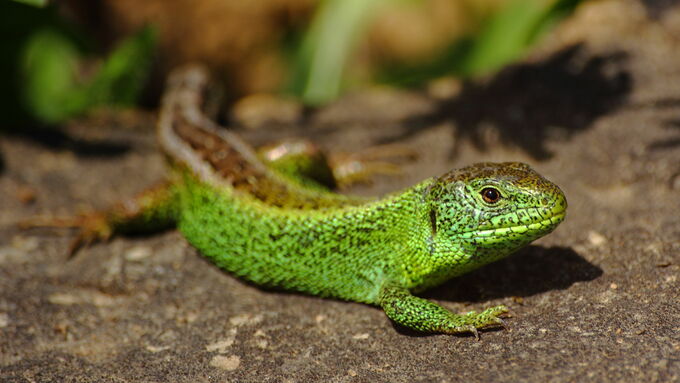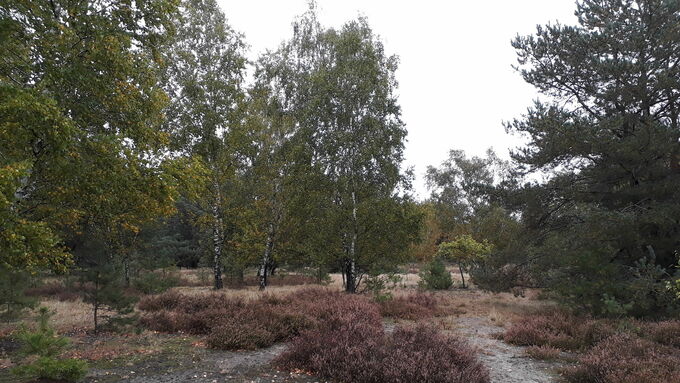The sand lizzard © Christoph Caina / Wikimedia Commons
main content
Project of the month
#6/2021 Between heath and forest
Dream landscape for the sand lizard at Camp Reinsehlen
In a forest-heath mosaic near Reinsehlen in the District of Heidekreis, measures to promote the sand lizard (Lacerta agilis) were carried out from 2019 to 2021. The city of Schneverdingen, as landowner and partner of the LIFE IP Atlantic Region DE, supported the measures.
Forest-heath complex with potential
The total area of 33.5 hectares borders directly on the large sandy grassland areas near Camp Reinsehlen. It is partly overgrown with heath, partly developed as nutrient-poor grassland and partly wooded. Due to the historical way of utilisation of grazing, the scenery is characterised by individual large-crowned oaks and beeches as former pastoral forest trees. The sand lizard has been recorded here several times. Adjacent to the east is the nature reserve ‘Lüneburger Heide’ which is highly relevant for the target species sand lizard and smooth snake (Coronella austriaca). However, some areas of the mosaic only provided a very limited habitat for the sand lizard. The open areas of the mosaic were in danger of being overgrown by young birch and pine trees, and the closed forest stands consisting mainly of pine trees had become dark and shady due to the invasive growth of black cherry (Prunus serotina).
The vision
The aim of this action was to create reptile-friendly transition areas between open land and sparse forest areas and to connect areas thereby. In addition, the structural diversity of the area should be increased so that the sand lizards can use many small-scale habitats. In the forest areas, a mixed oak forest on poor, dry sandy soils with forest heath and berry and shrub stands is to be developed in the long term.
Network and structural diversity
In a first step, the black cherry stands were cleared in certain areas by mini excavators. To further clear the forest areas, a heavy thinning followed so that the remaining trees only form a sparse canopy. In a second step, former open areas were cleared. By felling selected trees, free corridors between the areas were created. In addition, 15 deadwood piles were distributed in the area, where sand lizards can sunbathe or hide. During the work, the open sandy soil was revealed in some places; these serve ideally as egg deposition sites for the animals.
The smooth snake may also benefit from these measures. Although there have not been any direct records of this very cryptic snake species in the area, one animal was found in the vicinity at Wintermoor railway station. Thus, smooth snakes might use the railway line near Camp Reinsehlen as a dispersal corridor and thus migrate into the area.
For butterfly species, such as the rock grayling (Hipparchia hermione), the removal of barriers between open areas is also very important for increasing their habitats. The open sandy areas can be colonised by sand-loving insects.
Outlook
Through the lighter design of the forest-heath mosaic with more structures, the sand lizard will hopefully feel even more at home here in the future. In 2023, the agile animals will be monitored for the next time.
The local herding with goats and heath sheep can now also include the new open areas, so that effective repression of the woody plants is possible. The city of Schneverdingen will continue to support the ‘animal landscape workers’ with mechanical work.





